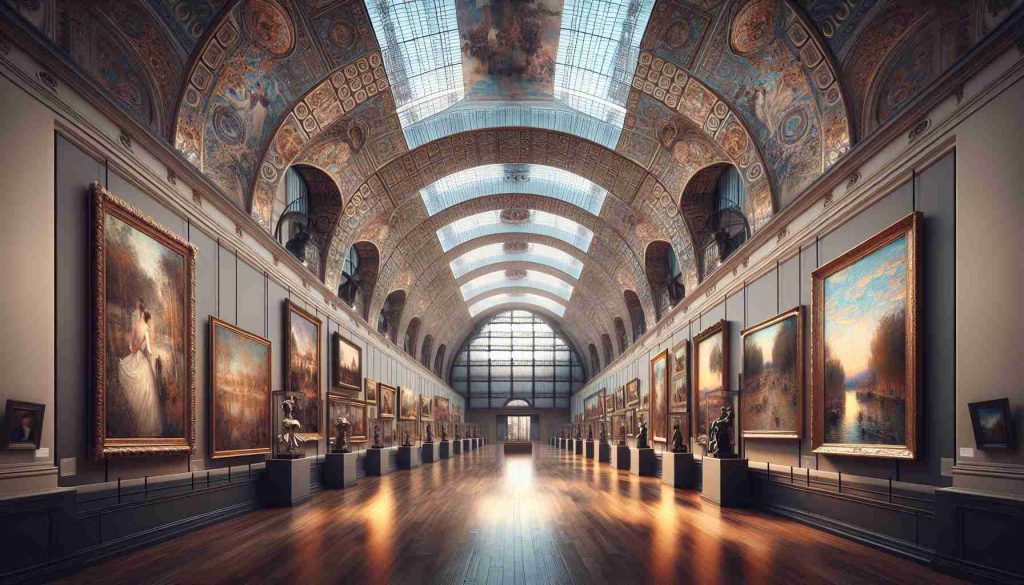Orsay Museum Celebrates 150 Years of Impressionism with Immersive Exhibition and Virtual Reality Journey

The Orsay Museum in Paris is honoring the 150th anniversary of the groundbreaking art movement, Impressionism, with a remarkable exhibition that brings together iconic masterpieces and offers visitors a unique virtual reality experience. Titled „Paris 1874: Inventing Impressionism,” the exhibition allows art enthusiasts to immerse themselves in the streets, salons, and picturesque locations that defined this revolutionary period.
Using innovative VR technology, visitors can transport themselves back in time to April 15, 1874. Wearing VR helmets, they can stroll alongside renowned artists such as Claude Monet, Edgar Degas, and Paul Cezanne. This pivotal day marked their decision to break away from the traditional art Salon and organize their independent exhibition, now considered the birth of Impressionism.
The Orsay Museum has gathered an impressive collection of 160 paintings from that momentous year, including many of the celebrated works that were showcased during the exhibition. Among these treasures are Monet’s „Impression, Sunrise,” the painting that gave the movement its name, and „Boulevard des Capucines,” which provides a glimpse into the actual exhibition venue.
Impressionist artists captured the essence of everyday life in their paintings, using rapid brushstrokes and a spontaneous style. From Degas’s ballet dancers to Camille Pissarro’s idyllic countryside scenes and Auguste Renoir’s lively party on the banks of the Seine in „Bal du Moulin de la Galette,” these artworks reflected the energy and dynamism of a changing world, emerging from the aftermath of war and revolution.
Co-curator Sylvie Patry emphasizes the Impressionists’ desire to depict the evolving world. „They wanted to paint the world as it is, one in the midst of major change,” she explains. „They were interested in new subjects: railways, tourism, the world of entertainment… They wanted to put sensations, impressions, the immediate moment at the heart of their painting.”
Thanks to loans from institutions such as the National Gallery in Washington, this exhibition offers a rare opportunity to see these paintings together for the first time in 150 years. Furthermore, the display includes works from the official Salon of that year, highlighting the rejection of traditional formalism by the Impressionists while also acknowledging the gradual adoption of new artistic styles by various painters.
The exhibition will take place at the Orsay Museum until July 14 before moving to Washington in September. Additionally, the virtual reality experience will be available until the end of the Paris Olympics on August 11. This immersive and enlightening journey into the world of Impressionism is a must-see for art enthusiasts and history lovers alike, providing a fresh perspective on the legacy of this extraordinary movement.
Muzeum Orsay w Paryżu oddaje hołd 150. rocznicy przełomowego ruchu artystycznego Impresjonizmu, prezentując niezwykłą wystawę, która skupia ikoniczne arcydzieła i oferuje zwiedzającym unikalne doświadczenie wirtualnej rzeczywistości. Zatytułowana „Paryż 1874: Wymyślanie impresjonizmu”, wystawa pozwala miłośnikom sztuki zanurzyć się w ulicach, salonach i malowniczych miejscach, które definiowały tę rewolucyjną epokę.
Dzięki innowacyjnej technologii VR, zwiedzający mogą przenieść się w czasie do 15 kwietnia 1874 roku. Zakładając hełmy VR, mogą przechadzać się wzdłuż znanych artystów takich jak Claude Monet, Edgar Degas i Paul Cézanne. Ten przełomowy dzień oznaczał ich decyzję o odejściu od tradycyjnego Salonu Sztuki i zorganizowaniu niezależnej wystawy, która obecnie uważana jest za narodziny impresjonizmu.
Muzeum Orsay zgromadziło imponującą kolekcję 160 obrazów z tego doniosłego roku, w tym wiele znanych dzieł, które były prezentowane podczas wystawy. Wśród tych skarbów są „Impresja, wschód słońca” Moneta, obraz, który dał ruchowi jego nazwę, oraz „Bulwar Capucines”, który daje wgląd w rzeczywiste miejsce wystawy.
Impresjoniści uchwycili istotę codziennego życia w swoich obrazach, używając szybkich pociągnięć pędzla i spontanicznego stylu. Od baletnic Degasa, przez sielskie pejzaże Camille’a Pissarro, po radosną zabawę Auguste’a Renoira na brzegu Sekwany w „Bal du Moulin de la Galette”, te dzieła odzwierciedlały energię i dynamikę zmieniającego się świata, wynikającą z następstw wojny i rewolucji.
Współkuratorka Sylvie Patry podkreśla pragnienie impresjonistów, aby przedstawić ewoluujący świat. „Chcieli malować świat takim, jakim jest, w fazie istotnych zmian” – wyjaśnia. „Interesowali się nowymi tematami: koleją, turystyką, światem rozrywki… Chcieli włożyć w serce swojego malarstwa uczucia, wrażenia, chwile chwytane z życia”.
Dzięki pożyczkom instytucji takich jak National Gallery w Waszyngtonie, ta wystawa daje rzadką okazję zobaczenia tych obrazów po raz pierwszy od 150 lat. Dodatkowo, na wystawie prezentowane są prace z oficjalnego Salonu Sztuki z tego roku, podkreślając odrzucenie tradycyjnego formalizmu przez impresjonistów i jednocześnie uwzględniając stopniowe przyjęcie nowych stylów artystycznych przez różnych malarzy.
Wystawa odbędzie się w Muzeum Orsay do 14 lipca, a następnie przeniesie się do Waszyngtonu we wrześniu. Dodatkowo, do końca Letnich Igrzysk Olimpijskich w Paryżu, czyli 11 sierpnia, będzie można korzystać z doświadczenia wirtualnej rzeczywistości. Ta zanurzająca i pouczająca podróż w świat impresjonizmu jest koniecznym punktem dla miłośników sztuki i pasjonatów historii, dając świeże spojrzenie na dziedzictwo tego wyjątkowego ruchu.
The source of the article is from the blog cheap-sound.com